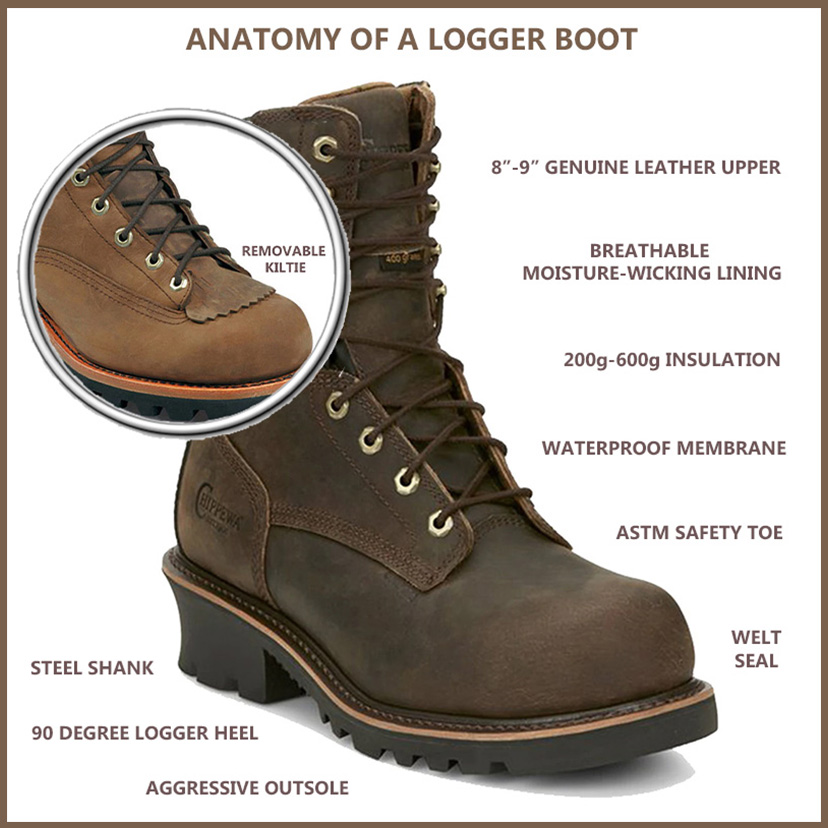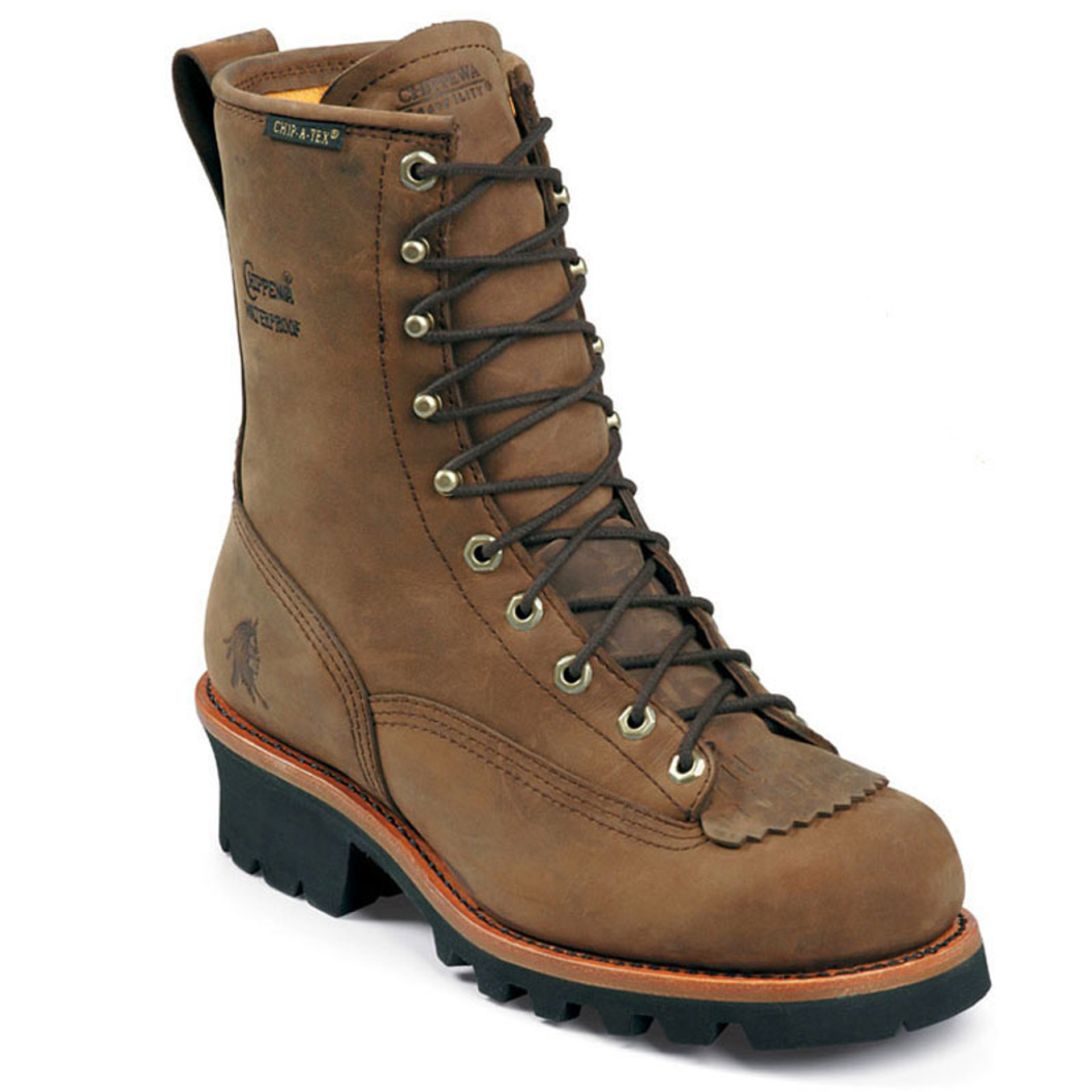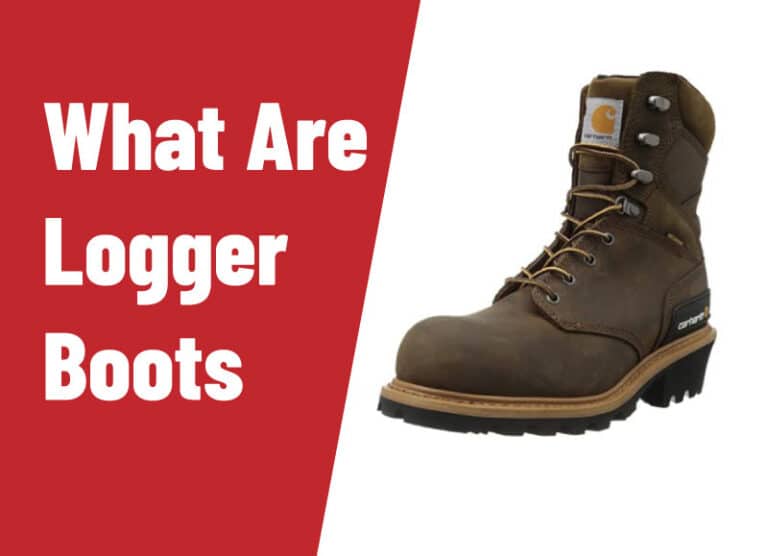What Makes a Logger Boot Unique?
Logger boots are a type of footwear that’s specifically designed to meet the demands of rugged outdoor activities. But what sets them apart from other types of boots? At their core, logger boots are built to provide unparalleled support, protection, and comfort for individuals who spend extended periods on their feet in challenging environments.
One of the key features that makes logger boots unique is their rugged outsole, which is specifically engineered to grip various terrain types, from muddy forests to rocky trails. This aggressive tread pattern ensures that wearers can maintain their footing, even in the most treacherous conditions. Additionally, logger boots often feature high ankle support, which provides added stability and protection from twists and sprains.
Another important aspect of logger boots is their waterproofing or water-resistance, making them an excellent choice for individuals who work or play in wet environments. Whether you’re a logger, construction worker, or outdoor enthusiast, a good pair of logger boots can make all the difference in your performance and overall well-being. So, what is a logger boot? In essence, it’s a type of footwear that’s specifically designed to meet the demands of rugged outdoor activities, providing a unique combination of protection, comfort, and performance that’s hard to find in other types of footwear.
The History of Logger Boots: From Lumberjacks to Modern-Day Wear
The origins of logger boots can be traced back to the early 20th century, when lumberjacks and loggers required rugged, durable footwear to navigate the treacherous terrain of the forest. These early boots were often handmade, with thick leather uppers and sturdy soles designed to withstand the harsh conditions of the logging industry.
As the logging industry evolved, so did the design and construction of logger boots. In the mid-20th century, manufacturers began to incorporate new materials and technologies into their boots, such as waterproof membranes and breathable linings. This led to the development of more comfortable, versatile boots that could be worn not only for logging but also for other outdoor activities.
In recent years, the logger boot industry has continued to adapt to changing needs and preferences. Modern logger boots often feature advanced materials and technologies, such as Gore-Tex membranes and Vibram soles, which provide improved waterproofing, breathability, and traction. Additionally, many manufacturers now offer a range of styles and designs to cater to different occupations and activities, from traditional logging to outdoor guiding and construction.
Despite these changes, the core principles of logger boot design have remained the same: to provide rugged, durable, and comfortable footwear for individuals who work and play in challenging outdoor environments. Whether you’re a logger, construction worker, or outdoor enthusiast, a good pair of logger boots is an essential investment for anyone who spends time on their feet in the great outdoors.
How to Choose the Right Logger Boot for Your Needs
Selecting the perfect logger boot can be a daunting task, especially with the numerous options available in the market. However, by considering a few key factors, you can make an informed decision that meets your specific needs and preferences.
First and foremost, consider the terrain you’ll be working or playing in. If you’ll be navigating rugged, rocky terrain, look for boots with aggressive tread patterns and deep lugs for maximum traction. On the other hand, if you’ll be working in wet or slippery conditions, opt for boots with waterproof membranes and slip-resistant soles.
Weather conditions are another crucial factor to consider. If you’ll be working in extreme cold or heat, look for boots with insulation and breathable materials to keep your feet comfortable. Additionally, consider the level of waterproofing you need, depending on the amount of rain or snow you’ll be exposed to.
Personal comfort is also essential when choosing a logger boot. Consider the height of the boot, the width of the toe box, and the level of ankle support you need. If you have specific foot issues, such as plantar fasciitis or flat feet, look for boots with features that cater to those needs, such as arch support or cushioning.
When trying on boots, make sure to wear the same type of socks you’ll be wearing on the job or during outdoor activities. Walk around the store to ensure the boots are comfortable and provide adequate support. Finally, evaluate the quality of the boots by inspecting the materials, stitching, and construction.
By considering these factors and taking the time to try on and evaluate different boots, you can find the perfect logger boot that meets your unique needs and preferences. Remember, a good pair of logger boots is an investment in your comfort, safety, and performance, so take the time to get it right.
Logger Boot Materials: Leather, Synthetic, and Everything in Between
When it comes to logger boots, the choice of material can make all the difference in terms of durability, water resistance, and breathability. In this section, we’ll explore the various materials used in logger boot construction, including leather, synthetic materials, and hybrid options.
Leather logger boots are a classic choice, offering exceptional durability and resistance to abrasion. High-quality leather boots can last for years with proper care, making them a worthwhile investment for outdoor workers and enthusiasts. However, leather boots can be heavy, stiff, and prone to waterlogging, which can compromise their performance in wet conditions.
Synthetic materials, such as polyurethane and polyvinyl chloride (PVC), offer a more affordable and lightweight alternative to leather. Synthetic boots are often more water-resistant and easier to clean than leather boots, making them ideal for wet or dirty work environments. However, synthetic materials can be less durable than leather and may not provide the same level of ankle support and stability.
Hybrid boots, which combine leather and synthetic materials, offer a compromise between the two. These boots often feature a leather upper with synthetic materials used in the sole and other components. Hybrid boots provide a balance of durability, water resistance, and breathability, making them a popular choice among outdoor workers and enthusiasts.
In addition to these materials, some logger boots may feature advanced technologies, such as Gore-Tex or eVent membranes, which provide enhanced waterproofing and breathability. Other features, such as insulation, cushioning, and arch support, can also enhance the comfort and performance of logger boots.
Ultimately, the choice of material will depend on your specific needs and preferences. By understanding the pros and cons of each material, you can make an informed decision when selecting the perfect logger boot for your needs.
Logger Boot Brands: Top Picks for Quality and Performance
When it comes to logger boots, not all brands are created equal. In this section, we’ll highlight some of the most reputable brands known for producing high-quality logger boots that meet the demands of outdoor workers and enthusiasts.
Timberland is a well-known brand that has been producing high-quality logger boots for decades. Their boots are known for their rugged durability, waterproofing, and comfort. With a wide range of styles and features to choose from, Timberland is a popular choice among outdoor enthusiasts.
Dr. Martens is another iconic brand that has been producing high-quality footwear for generations. Their logger boots are known for their air-cushioned soles, breathable materials, and comfortable fit. Dr. Martens offers a range of styles and features, from classic designs to more modern, high-tech options.
Thorogood is a US-based brand that specializes in producing high-quality, made-in-the-USA logger boots. Their boots are known for their exceptional durability, comfort, and support, making them a popular choice among outdoor workers and enthusiasts. Thorogood offers a range of styles and features, including waterproofing, insulation, and slip-resistance.
Other notable brands include Danner, Georgia Boot, and Irish Setter, each offering their own unique features and benefits. When choosing a logger boot brand, consider factors such as quality, durability, comfort, and price. Read customer reviews, try on boots, and evaluate the features and benefits of each brand to find the perfect pair for your needs.
Ultimately, the right brand and style of logger boot will depend on your specific needs and preferences. By considering the unique features and benefits of each brand, you can make an informed decision and invest in a pair of logger boots that will meet your demands for years to come.
Logger Boot Care and Maintenance: Tips for Long-Lasting Performance
Proper care and maintenance are essential for extending the lifespan of logger boots. With regular cleaning, conditioning, and storing, you can ensure your boots remain in top condition, providing optimal performance and comfort.
Cleaning your logger boots is a crucial step in maintaining their quality. Remove dirt and debris using a soft-bristled brush or a damp cloth. Avoid using harsh chemicals or abrasive materials that can damage the materials. For tougher stains, use a gentle cleaning solution specifically designed for the type of material your boots are made of.
Conditioning is another vital step in logger boot care. Apply a conditioner or waterproofing agent to the boots, paying special attention to the seams and stitching. This will help to repel water, prevent cracking, and maintain the boots’ breathability.
When storing your logger boots, make sure to keep them in a cool, dry place away from direct sunlight. Avoid stacking or compressing the boots, as this can cause creasing or damage to the materials. Consider using a boot tree or stuffing the boots with paper to maintain their shape.
In addition to these tips, it’s essential to inspect your logger boots regularly for signs of wear and tear. Check the soles for excessive wear, the uppers for cracks or tears, and the laces for fraying. Addressing these issues promptly can help prevent more significant problems from developing.
By following these simple care and maintenance tips, you can extend the lifespan of your logger boots, ensuring they continue to provide comfort, support, and protection for years to come. Remember, a well-maintained pair of logger boots is an investment in your safety, comfort, and overall well-being.
Logger Boots for Specific Occupations: Meeting the Demands of Different Jobs
Logger boots are not a one-size-fits-all solution. Different occupations require unique features and specifications to meet the demands of the job. In this section, we’ll explore how logger boots cater to specific occupations, such as logging, construction, and outdoor guiding.
For loggers, logger boots need to provide exceptional ankle support, rugged outsoles, and waterproofing to withstand the harsh conditions of the forest. Brands like Timberland and Thorogood offer logger boots specifically designed for logging, with features like steel toes, slip-resistant soles, and breathable membranes.
In the construction industry, logger boots need to be durable, comfortable, and protective. Look for boots with reinforced materials, ankle support, and slip-resistant soles to prevent accidents on the job site. Brands like Dr. Martens and Georgia Boot offer construction-specific logger boots that meet these demands.
Outdoor guides and enthusiasts require logger boots that are both functional and comfortable. Boots with breathable membranes, moisture-wicking linings, and cushioned insoles are ideal for long days on the trail. Brands like Danner and Irish Setter offer logger boots designed for outdoor enthusiasts, with features like waterproofing, insulation, and adjustable lacing systems.
Other occupations, such as firefighters, emergency responders, and outdoor workers, also require specialized logger boots. These boots need to meet specific safety standards, such as NFPA or ASTM certification, and provide features like heat resistance, flame retardancy, and slip resistance.
Regardless of the occupation, logger boots need to provide comfort, support, and protection. By understanding the unique demands of each job, manufacturers can design logger boots that meet the specific needs of workers and enthusiasts alike.
Conclusion: Why Logger Boots Remain a Timeless Choice
In conclusion, logger boots have come a long way from their humble beginnings as traditional lumberjack footwear. Today, they offer a unique combination of durability, comfort, and versatility that makes them an ideal choice for outdoor workers and enthusiasts alike.
Whether you’re a logger, construction worker, or outdoor guide, logger boots provide the necessary support, protection, and comfort to get the job done. With their rugged outsoles, high ankle support, and waterproofing, logger boots are designed to withstand the toughest conditions.
From leather to synthetic materials, logger boots cater to different preferences and needs. Reputable brands like Timberland, Dr. Martens, and Thorogood offer high-quality logger boots that meet the demands of various occupations.
By understanding the unique features and benefits of logger boots, individuals can make informed decisions when selecting the perfect pair for their needs. With proper care and maintenance, logger boots can last for years, providing a worthwhile investment for those who rely on them.
So, what is a logger boot? It’s more than just a pair of boots – it’s a symbol of rugged individualism, a testament to the power of human ingenuity, and a trusted companion for those who dare to venture into the great outdoors.
Invest in a pair of logger boots today, and experience the comfort, support, and durability that has made them a timeless choice for generations of outdoor enthusiasts.









